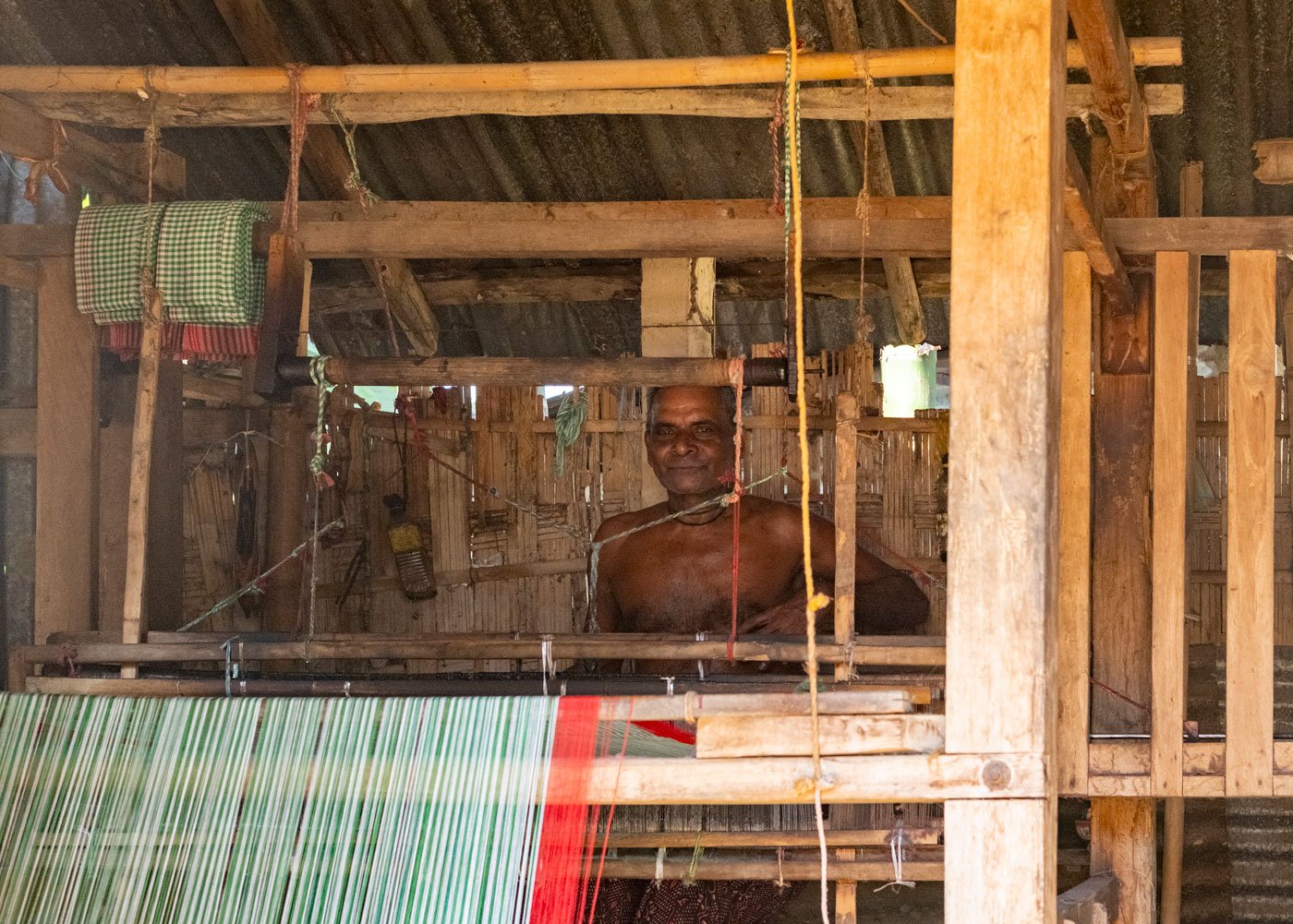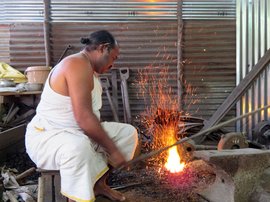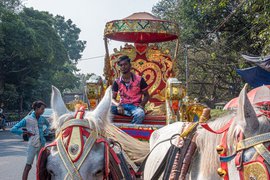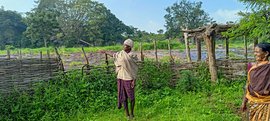“There is no shortage of weavers here on paper but it’s all over [practically] once I die,” sighs Roopchand Debnath as he takes a break from weaving on the handloom in his bamboo hut. Apart from the loom, which takes up most of the space, are piles of junk – broken furniture, metal spare parts and pieces of bamboo, among other things. There is barely any room for more than one person.
Roopchand, 73, lives in Gobindapur on the outskirts of Dharmanagar city, on the border of India and Bangladesh, in the state of Tripura. A narrow pitch road leads into the village, once home to 200 weaver families and over 600 artisans, according to the locals. The office of the Gobindapur Handloom Weavers’ Association stands among the few houses in narrow lanes, its corroded walls a reminder of mostly forgotten glory.
“There was not a single house here that did not have a loom,” recounts Roopchand, who belongs to the Nath community (listed as Other Backward Classes in the state). The sun is bright and he wipes the sweat off his face before continuing. “Society used to respect us. Now, no one cares. Tell me who would respect a profession that doesn’t have any money?” he asks, voice cracking with emotion.
The veteran weaver recalls making the handwoven nakshi sarees which had elaborate floral motifs. But in the 1980s, “when Purbasha [the handcraft emporium of the Government of Tripura] opened an outlet in Dharmanagar they told us to discontinue making nakshi sarees and start making plain sarees,” says Roopchand. These were low on detailing and overall quality, and hence cheaper.
Slowly, he said,
nakshi
sarees
faded out
in the region, and today, he adds, “there are neither any artisans left nor the
supply of spare parts for the looms.” His words are echoed by Rabindra Debnath,
acting the President of the Weavers’ Association for the last four years who
says, “there was no market for the clothes we used to make.” At 63, he cannot
keep up with the physical demands of weaving any more.


Left: Roopchand Debnath (standing behind the loom) is the last handloom weaver in Tripura's Gobindapur village, and only makes gamchas now. Standing with him is Rabindra Debnath, the current president of the local weavers' association. Right: Yarns are drying in the sun after being treated with starch, ensuring a crisp, stiff and wrinkle-free finish
By 2005, Roopchand had stopped weaving nakshi sarees altogether and switched to the gamcha . “We never used to make gamchas . All of us wove only sarees. But we had no choice,” recounts one of the last masters of the loom in Gobindapur. “Since yesterday, I have woven just two gamchas . I will make barely 200 rupees selling these,” says Roopchand and adds, “this is not my earning alone. My wife helps me with winding the yarn. So it is the earning of an entire family. How does one survive with this income?”
Roopchand gets down to weaving after breakfast, around 9 a.m. and continues till a little after noon. He pauses for a bath and lunch before resuming work. He usually does not work in the evenings now, as it causes his joints to ache. But when he was younger, Roopchand says, “I even worked till late in the night.”
At the loom, most of Roopchand’s working day is spent weaving gamchas. Due to their cheaper price and longevity, gamchas still haven't fallen out of use in many households here and in wide regions in Bengal. “The gamchas I weave are [mostly] made this way”, Roopchand points to the white and green yarns being weaved into the body of the gamcha with bright red yarns weaved into thick bands outlining the borders. “We used to dye these yarns ourselves before. For the last 10 years or so, we have been purchasing dyed yarns from the Weavers’ Association,” he tells us and adds that he uses the gamchas that he weaves.
But when did things change in the handloom
industry? Roopchand says, “it was primarily with the introduction of power
looms and a decline in the quality of yarns. Weavers like us can’t compete with
power looms.”


Left: Spool winding wheels made of bamboo are used for skeining, the process of winding thread on a rotating reel to form a skein of uniform thickness. This process is usually performed by Basana Debnath, Roopchand's wife. Right: Bundles of yarns to be used for weaving
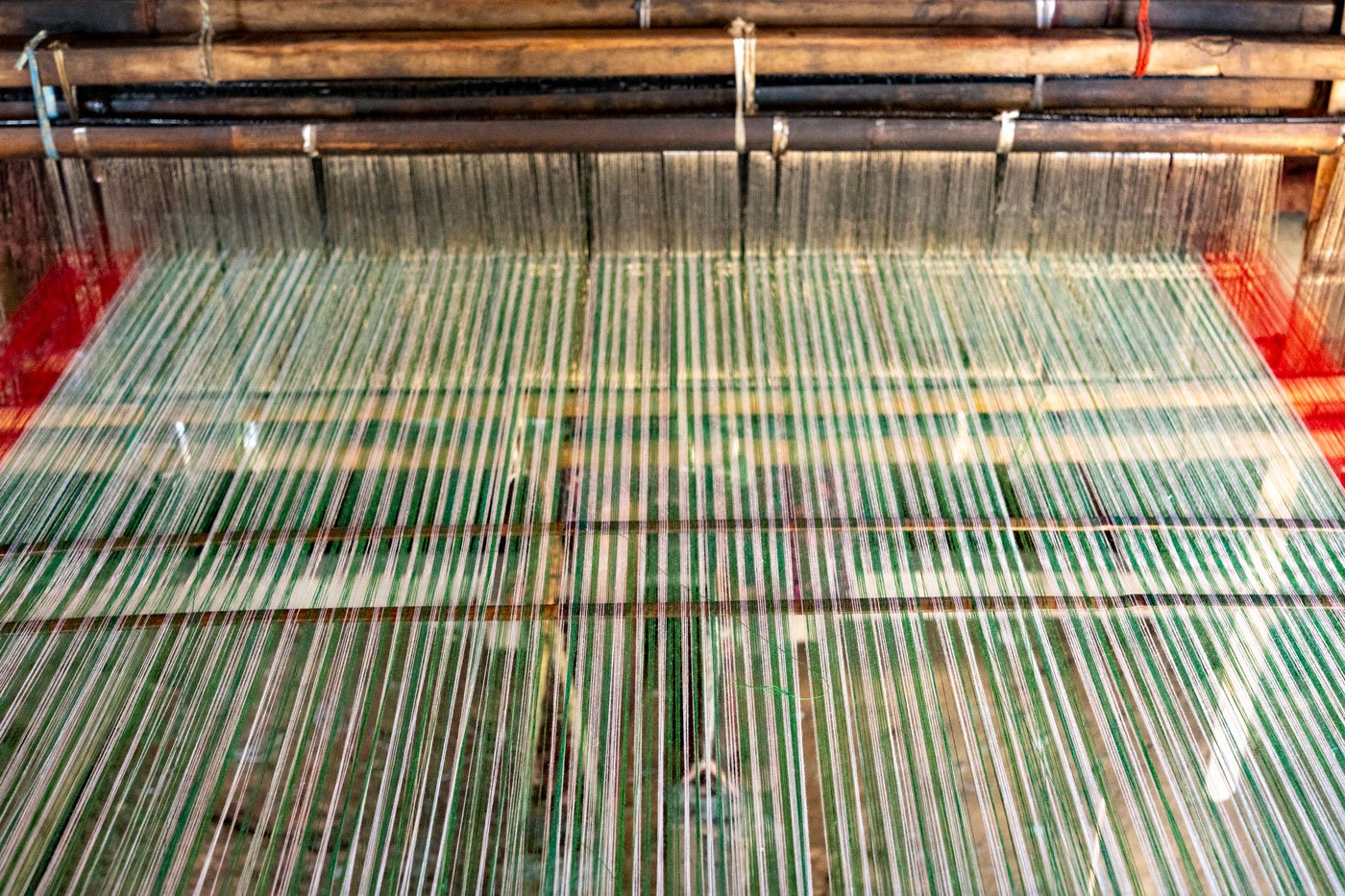

Left: Roopchand learnt the craft from his father and has been in weaving since the 1970s. He bought this particular loom around 20 years ago. Right: Roopchand weaving a gamcha while operating the loom with his bare feet
Powerlooms are expensive, making it difficult for most weavers to make the switch. Additionally, in villages such as Gobindapur, there are no shops that sell spare parts for the loom and repair work is challenging which was a deterrent for many of the weavers. Now, Roopchand says, he is too old to wield the machinery.
“I recently bought yarns [22 kg] worth 12,000
[rupees] which used to cost me around 9000 last year; with this health it will
take me around 3 months to make around 150
gamchas
out of them. …and I will sell them [to the weaver’s association] for just
around 16,000 rupees,” Roopchand says helplessly.
*****
Roopchand was born in Sylhet, Bangladesh around 1950 and immigrated to India in 1956. “My father continued weaving here in India. I studied till Class 9 before dropping out of school,” he says. The young Roopchand then took a job at the local electricity department, “the work was too demanding, and the pay, too low, so I quit after four years.”
He then decided to learn how to weave from his
father, a generational weaver. “The handloom [industry] paid well at that time.
I have even sold sarees for 15 rupees. I couldn’t have paid my medical expenses
or marry off my [three] sisters had I not been in this craft,” he says.


Left: Roopchand began his journey as a weaver with nakshi sarees which had elaborate floral motifs. But in the 1980s, they were asked by the state emporium to weave cotton sarees with no designs. By 2005, Roopchand had switched completely to weaving only gamcha s. Right: Basana Debnath helps her husband with his work along with performing all the household chores


Left: There may be many difficulties in the handloom industry now, but Roopchand does not want to quit. 'I have never put greed before my craft,' he says. Right: Roopchand winding thread to form skeins
Basana Debnath, his wife, remembers that she started helping him to weave right after they got married. “We used to have four looms at that time and he was still learning from my father-in-law,” she says over the sound of her husband operating the loom in the other room.
Basana’s days run longer than Roopchand. She wakes up early, performs the household chores and prepares lunch before helping her husband with winding yarns. Only in the evening is she able to get some rest. “All the work of winding the yarn and making skeinings is done by her,” Roopchand proudly acknowledges.
Roopchand and Basana have four children. Two
daughters are married, and his two sons (one a mechanic and other a jeweller)
live not too far away from their residence. When asked if people are losing
touch with traditional art and craft, the maestro introspects, “even I have
failed. Why else could I not inspire my own children?”
*****
Across India, the household income of 93.3 percent of handloom workers is below Rs. 10,000 while in Tripura, 86.4 per cent of the household income of handloom workers is below Rs. 5,000 ( Fourth All India Handloom Census , 2019-2020).
“The craft has been dying slowly here,” says
Arun Bhowmik, Roopchand’s neighbour, “we are not doing enough to preserve it.”
His thoughts are echoed by Nanigopal Bhowmik, another senior resident of the
village, “people want to work less and earn more,” he sighs and says. “Weavers
have [always] lived in huts and mud houses. Who wants to live like that?”
Roopchand also adds.


Left: Roopchand and Basana Debnath in front of their mud house . Right: A hut made from bamboo and mud with a tin roof serves as Roopchand's workspace
Apart from a lack of income, health issues, many of them long-term, plague the weavers. “My wife and I spend 50-60,000 rupees just on medical bills every year,” says Roopchand. The couple suffer from shortness of breath and cardiac complications, a fallout of the profession.
There have been some efforts by the government to preserve the craft. But Roopchand and others in the village think it is not making a difference. “I have trained over 300 weavers through the Deen Dayal Hathkharga Protsahan Yojana [a central government initiative launched in 2000],” Roopchand says. “It is hard to get trainees,” he continues, “people mostly show up for the stipend. It is not possible to produce skilled weavers like this.” The state of affairs is made worse by “the mismanagement of handloom storage, infestation by wood mites and destruction of yarn by rats,” Roopchand adds.
Handloom exports have decreased by almost 50 per cent between 2012 and 2022, from close to 3000 crores to around 1500 ( Handloom Export Promotion Council ) and the ministry funds have also dwindled.
The future of the handloom in the state looks bleak and Roopchand says, “I feel this is beyond repair.” But he pauses for a moment and is able to offer a solution. “More involvement from women would help,” he says, “I have seen a tremendous workforce, almost entirely run by women, in Sidhai Mohanpur [a commercial handloom production site in West Tripura].” One way of remedying the situation, he says, is a fixed daily wage for the existing artists.
When asked if he has ever thought of quitting, Roopchand smiles. “Never,” he says with resolve, “I have never put greed ahead of my craft.” There are tears in his eyes as he rests his hand on the loom. “She may leave me, but I never will.”
This story is supported by a fellowship from Mrinalini Mukherjee Foundation (MMF).